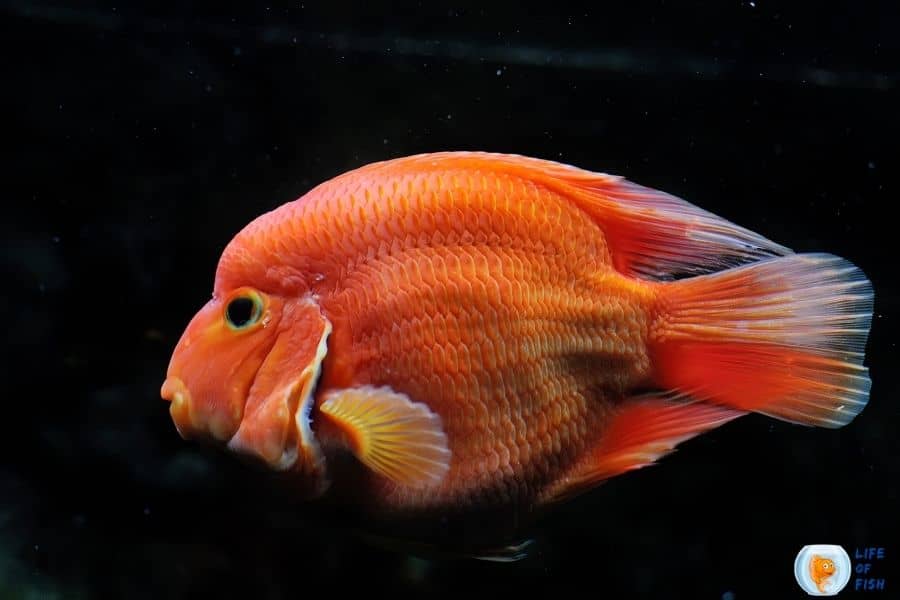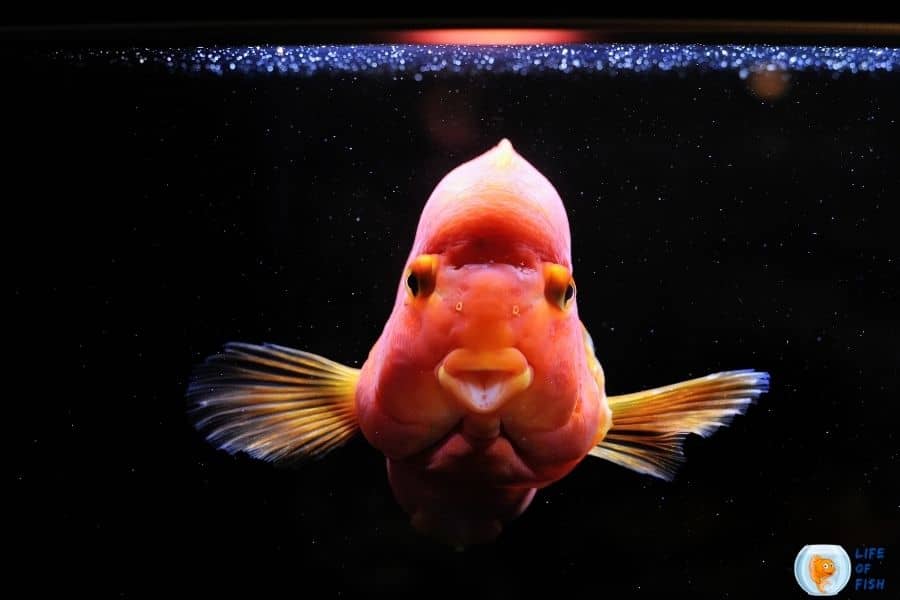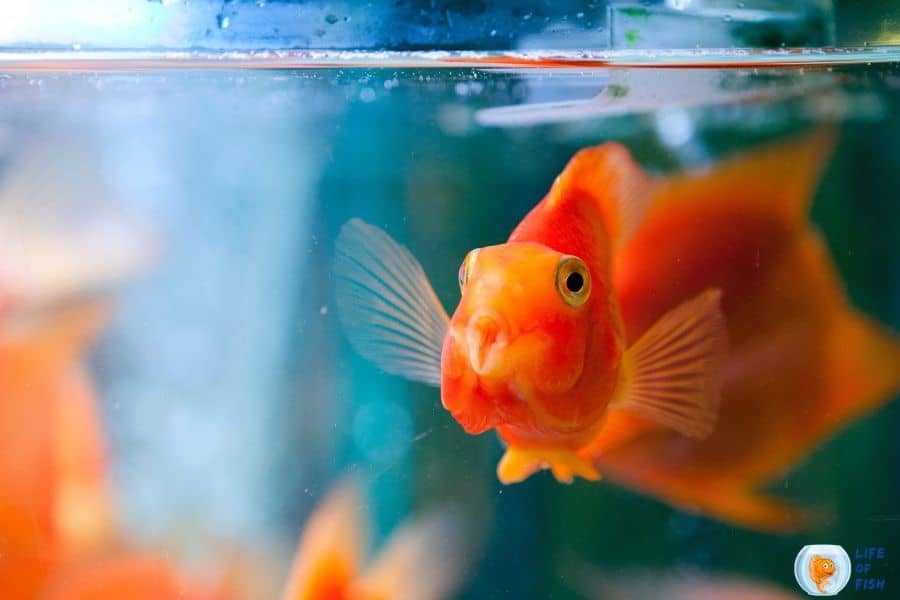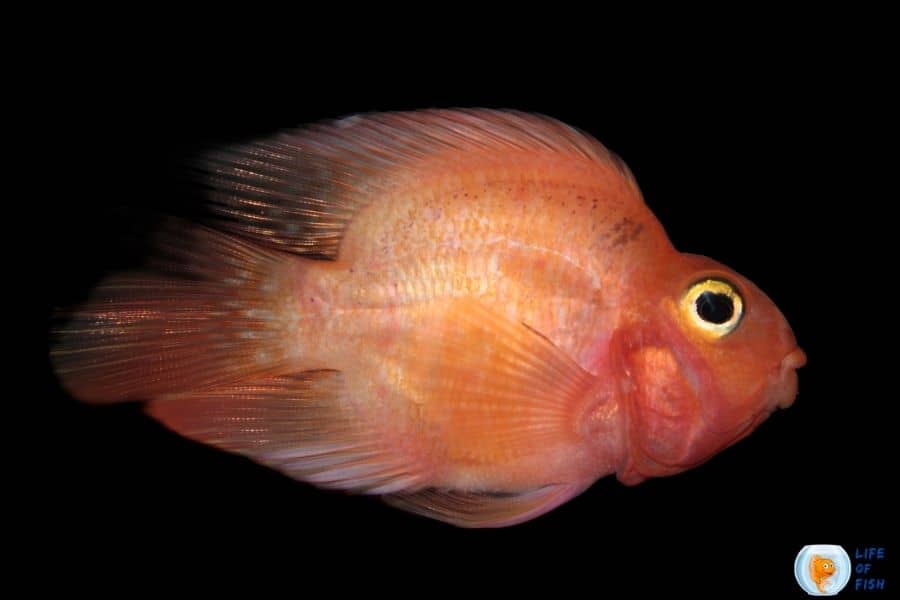Blood Parrot Cichlid is a gorgeous addition to your home aquarium. Blood parrot cichlids come in a variety of colors and have playful personalities. Here we will discuss some basic information about blood parrot cichlid tank size and more.
They are thought to be a hybrid between the Midas and the Gold Severum cichlid as the breeders have not confirmed their true identity.
These fish have made several conflicts over the years on their hybridization and their color morphs.
Whatever the conflicts are, they are still quite popular among aquarists worldwide.

Blood Parrot Cichlid Tank Size
Jump To
- 1 Blood Parrot Cichlid Tank Size
- 2 Blood parrot cichlid size
- 3 What is the minimum tank size for a blood parrot?
- 4 Can blood parrots live alone?
- 5 How many blood parrot cichlids can I keep together?
- 6 What is the ideal tank size for multiple blood parrots?
- 7 How many gallons do 2 blood parrots need?
- 8 How many blood parrots are in a 75-gallon tank
- 9 Why is my parrot fish so aggressive?
- 10 How fast do blood parrot cichlids grow?
- 11 How long does it take for a blood parrot to reach full size?
- 12 Can I keep a baby blood parrot with adult blood parrots?
- 13 Blood parrot cichlid tank mates
- 14 Related Questions
- 15 Conclusion
The minimum tank size for this freshwater fish is at least 30 gallons.
This will give them plenty of room to swim around, and you will not have to worry about them trying to get into some of your other fish’s territory.
However, keeping only one Blood parrot cichlid is not recommended as they are schooling fish.
If you prefer to keep more than one blood parrot cichlid, then you will have to buy a larger tank, depending on how many fish you want to house.
Blood parrot cichlid size
Blood parrot cichlids can grow about 8 inches long, but females tend to grow smaller than males. Female Blood parrot cichlids usually reach about 6 to 7 inches maximum.
Blood Parrot Cichlids have been known to reach lengths of 10 inches in rare cases. However, these fish are uncommon.
What is the minimum tank size for a blood parrot?
For one Blood parrot cichlid, you will need to have a tank size of at least 30 gallons. This will give your fish enough room to swim and explore without feeling too cramped.
However, keep in mind that these fish prefer to live in small schools. Keeping them alone will cause some problems, which we will explain below.
Can blood parrots live alone?
You can keep blood parrots alone in your aquarium.
However, this will cause stress in your fish, and your fish will have behavior issues if kept alone.
If kept in isolation, Blood parrot cichlids tend to be shy and lack confidence. This may also lead to health problems as they do not have any company.
How many blood parrot cichlids can I keep together?
You can keep about 3 or 4 Blood Parrot Cichlids together in the same tank. Remember that you should not keep more than 6 of these fish together.
If you have too many blood parrots in the same tank, they will become territorial and start beating up on each other. To minimize this problem, you will have to provide a massive-sized aquarium.
They are schooling fish and need to be kept in groups of 3 or more for optimum health.
What is the ideal tank size for multiple blood parrots?
If you keep multiple Blood Parrot Cichlids in your tank, the ideal tank size would be 100 gallons or more.
This will give them plenty of space to swim and explore without feeling cramped.
Keep in mind that these fish should be kept in schools of 3 or more. If you have less than 3 Blood parrot cichlids, you will see a decrease in their overall health and well-being.

How many gallons do 2 blood parrots need?
As we said before, one blood parrot cichlid needs at least 30 gallons to thrive.
If you intend to keep more Blood parrots, you will have to increase the tank size by 10 gallons for each additional fish.
However, these numbers are bare minimums and should only be used if you keep them by themselves.
If you intend to keep just two Blood Parrot Cichlids together, your best option would be a 50-gallon aquarium.
This will provide them with enough space and give them plenty of room to swim without any overcrowding.
How many blood parrots are in a 75-gallon tank
The general rule of tank size for Blood parrot cichlid is 30 gallons for the first one and 10 gallons more for each additional one.
So, if we calculate by this rule, a 75-gallon tank could house 5 Blood Parrot Cichlids. But, when you keep more than three fish together, they tend to become territorial.
Therefore, it is better to accommodate only three fish in a 75-gallon aquarium.
Why is my parrot fish so aggressive?
If your blood parrot fish become aggressive in your tank, they probably don’t have enough space to establish their territory.
When kept in groups, blood parrot fish will establish a dominant hierarchy. The largest and most aggressive fish will become the dominant ones.
If your tank is too small, the weaker fish may be bullied and become stressed. This can lead to a decrease in their overall health and well-being.
How fast do blood parrot cichlids grow?
Blood parrot cichlids have a prolonged growth rate, unlike their relatives Central American Cichlids and Flowerhorn Cichlids.
It will take around one year for these fish to reach about 5 to 6 inches, and then their growth rate dramatically slows down.
How long does it take for a blood parrot to reach full size?
Blood parrot cichlids will take around 5 to 8 years to reach their full size.
However, they will not stop growing until they are about ten years old.
Can I keep a baby blood parrot with adult blood parrots?
No, you should not house a baby blood parrot with adult blood parrots.
The baby will be bullied and may become stressed. This can lead to a decrease in their overall health and well-being.

Blood parrot cichlid tank mates
Blood Parrot cichlids do well in species-only tanks. They are schooling fish and prefer to accompany of their own kind.
However, you will have to provide ample space accordingly, or else these fish may show some aggressive behavior.
However, their fights remain as awkward pushing matches. So, that’s nothing to be afraid of as they don’t tend to kill other tank mates.
Still, you will have to provide enough space for each fish because these fights may lead to stress and illness in some cases.
If you prefer to keep other fish in your tank with them, you need to make sure that the other fish are not aggressive.
Aggressive fish will not get along with your Blood Parrot Cichlid and will pick on them.
You also need to ensure that the other fish in your tank can handle the temperament of your Blood Parrot Cichlid.
Smaller fish will not be able to hold their own in an aquarium with a Blood Parrot Cichlid as they can easily become lunch.
Make sure you research the other fish you want to put in your tank with your Blood Parrot Cichlid to ensure they are compatible.
If you keep multiple Blood Parrot Cichlids in your tank with other fish species, the ideal tank size would be at least 180 gallons.
Can you put blood parrots with African cichlids?
Keeping blood parrot cichlids with African cichlid is possible if you provide enough space for each fish and provide enough food.
However, this will not work well in the long run because African cichlids always out-compete blood parrots for food.
African cichlids are highly aggressive and voracious eaters.
Due to breeding deformities, blood parrot cichlids are not as aggressive as African cichlids and will not compete with them for food. In worst scenarios, African cichlids kill Blood Parrots.
Therefore, keeping both species together disadvantage blood parrots in the long run and usually only works when there is a huge tank and an abundance of food.
If you want to keep African cichlids in the same tank as Blood Parrot Cichlids, make sure you provide them with enough space.
You may also want to start your African cichlids on a diet of pellets to reduce the competition for food.
However, our recommendation is not to house blood parrots with African cichlids or the safety of your Blood parrot cichlid.
Can blood parrot cichlids live with Oscars?
Absolutely. As long as you feed both fish species enough, these fish will get along well with the Oscars.
They will not be attacked by the Oscars and will be left alone during their fights for territory.
But you must provide them with enough space for each fish because these fights may lead to stress and illness in some cases.
So, before you decide to keep Blood Parrot Cichlids with Oscars, make sure your tank is big enough for each fish and for the Oscars to have their own territory and that you provide enough food so that both species can thrive.

Related Questions
How much do blood parrot cichlids cost?
Blood parrot cichlids are not a cheap choice for your aquarium. Depending on its size and color, one specimen will cost you from $10 to $60.
These fish are difficult to breed as you always have to crossbreed the original parents to get the hybrid.
Although the females lay eggs, males do not fertilize them because all blood parrot males are sterile.
Are blood parrot fish smart?
Blood parrot cichlids are also intelligent and curious like their relatives, Cichlids.
They learn who will feed them and when they will be fed and interact with their owner when they are being fed.
They’ll also engage with other fish in the aquarium and one another and participate in fascinating behaviors.
Are blood parrots schooling fish?
Blood parrot cichlids are schooling fish that prefer to stay in schools. They often exhibit schooling behavior but mostly spend their time hidden away behind plants and rocks. That being said, they can also stay in solitary, but they are usually more comfortable and active when they are in a group.
Conclusion
Blood parrot cichlid is a mid-sized fish that need at least a 30-gallon aquarium for one fish.
If you expect to keep more than one blood parrot, you will have to provide extra 10 gallons (at least) for each additional fish.
They are lovely and unique to look at in your tank, but you must take care of their needs in order to keep them healthy and happy.
When choosing tank mates for your cichlids, remember that they are a timid species and may not fare well if housed with aggressive fish. Best tank mates are the same size, peaceful fish.
Read Next : Do Freshwater Parrotfish Eat Plants?| With Parrot Fish Feeding Behaviour|
